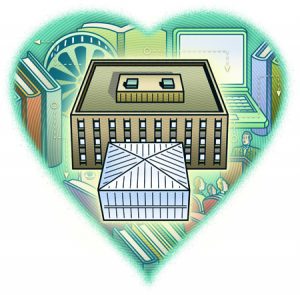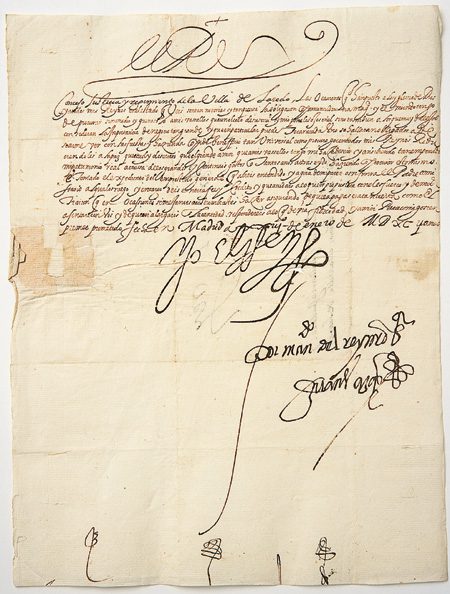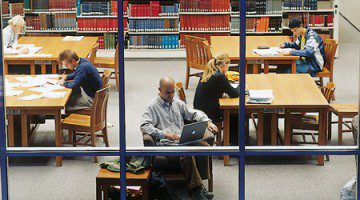Much more than a repository of books, the library is becoming a vibrant center for learning.
 Have you ever wondered which building at BYU is the most important? You might assume the administration building, where officials lead the university. Or maybe you would pick the Tanner Building, where the Marriott School trains future business leaders. Or perhaps the McKay Building would be your choice, since students prepare there to become teachers themselves. President Gordon B. Hinckley, however, suggested that the Harold B. Lee Library deserves the distinction. At the 2000 dedication of the library addition, he observed:
Have you ever wondered which building at BYU is the most important? You might assume the administration building, where officials lead the university. Or maybe you would pick the Tanner Building, where the Marriott School trains future business leaders. Or perhaps the McKay Building would be your choice, since students prepare there to become teachers themselves. President Gordon B. Hinckley, however, suggested that the Harold B. Lee Library deserves the distinction. At the 2000 dedication of the library addition, he observed:
Of all the wonderful buildings that we have on this campus, none, I believe, is as important as the library. A library is the very heart and substance of a university.
President Hinckley’s comparison of the library to the heart seems particularly appropriate at BYU. Located in the center of campus, as the heart is in the body, the library draws in information-hungry students and faculty and sends them out enriched with knowledge, the very lifeblood of a university.
With its 3.5 million volumes, the Harold B. Lee Library is rightly seen as the university’s storehouse of knowledge. But to keep pace with the changing rhythms of the university, the library has reinvented itself to become much more than just a book repository.
Through a variety of educational programs, the Lee Library has become one of BYU’s most innovative teaching facilities. For example, the library sponsors a lecture series dedicated to stimulating campus discussion of the latest research in disciplines taught at BYU. Students gather in the library’s auditorium to hear campus scholars address topics ranging from atom interferometry to the Lewis and Clark expedition. The library also offers free screenings of classic movies from its extensive archive of 16-mm films, includingGone with the Wind, King Kong, and Casablanca. With a brief lecture in place of popcorn and drinks, library movie night has become a standing-room-only event. Another teaching tool is the L. Tom Perry Special Collections Exhibit Gallery, which encourages visitors to ponder the interplay of historic individuals, ideas, and events through Special Collections holdings. Recent exhibits have explored Japanese art, Don Quixote, and religion’s role in the birth of America.
Along with providing new ways to teach, the library has also responded to changes in how students study and learn today. Students expressed interest in areas for group discussion and more access to technology. So the library created the Information Commons, or “No Shhh Zone,” where students are encouraged to talk out loud as they work in groups at tables with computers that run powerful software applications. The Information Commons also provides video cameras, sound recorders, and editing stations for students to develop multimedia presentations for their courses. One senior recently remarked that creating the Information Commons was the single “best thing” the university had done for him.
With its books, lectures, films, exhibits, and Information Commons, the library is becoming the central gathering place for learners at BYU, drawing more than 10,000 students and faculty each day. But recent changes have made it a destination for learners away from campus as well. To support students in their dorms, faculty at home, and alumni all over the world, the library has launched a major effort to put its learning resources online. Today, the library offers Web access to thousands of electronic journals and tens of thousands of digital books. It will soon offer streaming video and audio recordings across the Internet. Through the library’s “online collections” site, researchers can look for ancestors in 50,000 digital family histories, read past issues of BYU Studies, or view most of the Museum of Art’s holdings.
By becoming more central to learning at BYU and in the Church, the library is working to meet President Hinckley’s vision expressed at the 2000 addition dedication. There, he called libraries “a place for the ever-present challenge to dig for knowledge beyond that which is given in the classroom.”
Randy Olsen is the university librarian at BYU.
Learn more about library events, exhibits, and online collections at www.lib.byu.edu.









